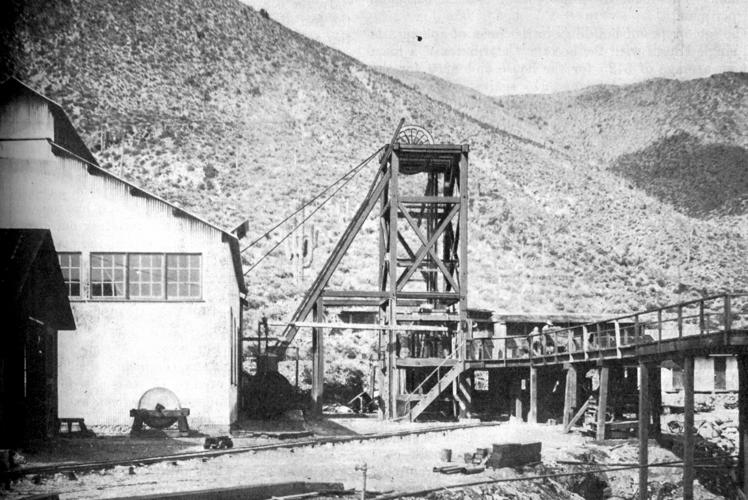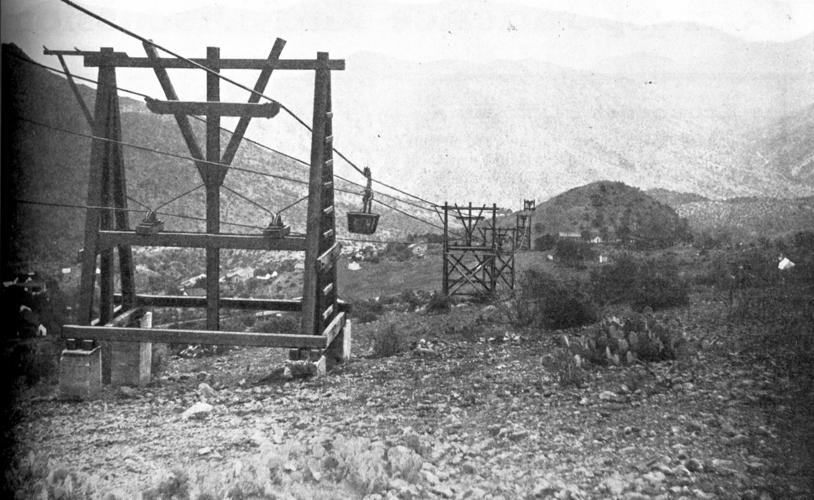Early 20th century methods of ore transport at the Christmas Mine in southern Gila County included a rail connection with Winkelman and a 3,600-foot aerial tramway connecting the mine to ore bins along the banks of the Gila River.
Construction of both occurred during the Saddle Mountain Mining Co’s oversight of the Christmas Mine in 1907. However, falling copper prices forced the Saddle Mountain Mining Co. to close its Christmas mining operation that same year.
Attempts to reopen the mine in 1909 by the Gila Copper Sulphide Co., a subsidiary company belonging to the Development Company of America controlled by Frank M. Murphy, proved unsuccessful. A 7.4-mile rail line from Winkelman to its terminus within 1½ miles from the Christmas Mine in Copper Canyon was completed on June 1, 1911, by the Arizona Eastern Railroad, a subsidiary of the Southern Pacific Railroad.
Rock slides and vertical cliffs made construction challenging, and necessitated the engineering of a 979-foot tunnel through solid granite. The total investment in construction cost $100,000 per mile, a cost-per-mile averaging four times more than similar railroad projects in the Arizona Territory.
Asarco acquired the Christmas operation in 1916, replacing the old tramway with a 7,300-foot Bleichert tramway, which had a 950-foot vertical drop connecting the Christmas Mine, with an upper ore-bin capacity of 250 tons, to a lower, 1,000 ton-capacity ore bin located at the terminal.
Cost of operation was 17.5 cents per ton in 1919. Ore was then shipped by rail to the Asarco smelter in Hayden.
Sam Knight, who operated the Sam Knight Mining Lease Inc., which employed 50 miners at the Christmas Mine during the 1940s, said the tramway was removed in 1934 and replaced by truck transport from the mine to the Christmas spur, a rail connection with the Southern Pacific Railroad. Knight’s affiliation with the mine dated back to his tenure as mill superintendent with the Christmas Copper Corp. in 1929.
Knight shipped 30,000 tons of ore annually from Christmas to the Hayden smelter until 1953. The ore was valuable in that it averaged 2.5 percent copper with a lime content of 30 percent. This high lime content, sought after for smelter fluxing, brought a higher market price, ensuring Knight’s enterprise was profitable.
In 1943, the Inspiration Consolidated Copper Co. acquired an option, subsequently purchasing the Christmas property. It further developed the property with the sinking of the 1,793-foot McDonald shaft by 1961 and the erection of a concentrator.
Inspiration Consolidated Copper Co. recognized the necessity to reassess methods of shipment. It abandoned the 7.4-mile rail line between Winkelman to Christmas that year for reasons of cost. It chose to ship its concentrates by truck to its own smelter in Miami, a distance of 38 miles compared to being obligated to the roundabout 400 miles of rail movement to Miami offered by the Southern Pacific.
Although the Southern Pacific Railroad was eager to retain the business of the Christmas Mine by potentially building a line over the Dripping Spring Mountains from Winkelman to Peridot, an Arizona Eastern Railroad rail stop on the way to Miami, the estimated mine reserves at Christmas failed to justify such expenditure. The former railroad grade became part of Highway 77, and an open cut replaced the old tunnel.





